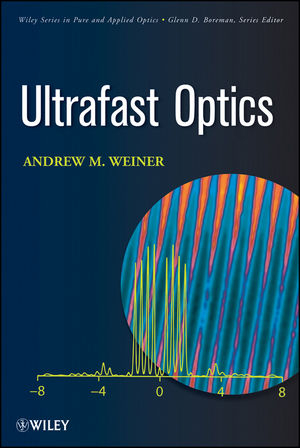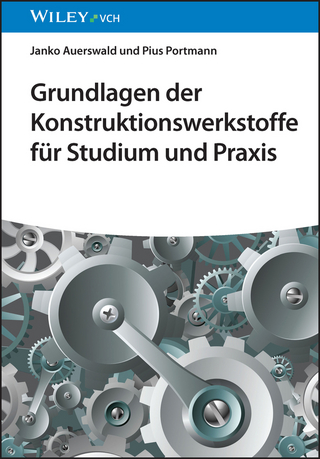
Ultrafast Optics
John Wiley & Sons Inc (Verlag)
978-0-471-41539-8 (ISBN)
A comprehensive treatment of ultrafast optics
This book fills the need for a thorough and detailed account of ultrafast optics. Written by one of the most preeminent researchers in the field, it sheds new light on technology that has already had a revolutionary impact on precision frequency metrology, high-speed electrical testing, biomedical imaging, and in revealing the initial steps in chemical reactions.
Ultrafast Optics begins with a summary of ultrashort laser pulses and their practical applications in a range of real-world settings. Next, it reviews important background material, including an introduction to Fourier series and Fourier transforms, and goes on to cover:
Principles of mode-locking
Ultrafast pulse measurement methods
Dispersion and dispersion compensation
Ultrafast nonlinear optics: second order
Ultrafast nonlinear optics: third order
Mode-locking: selected advanced topics
Manipulation of ultrashort pulses
Ultrafast time-resolved spectroscopy
Terahertz time-domain electromagnetics
Professor Weiner's expertise and cutting-edge research result in a book that is destined to become a seminal text for engineers, researchers, and graduate students alike.
Andrew M. Weiner is the Scifres Family Distinguished Professor of Electrical and Computer Engineering at Purdue University. Professor Weiner is the coeditor of two conference proceedings and has published six book chapters, over 200 journal articles, and over 350 conference papers. His research focuses on ultrafast optical signal processing, high-speed optical communications, and ultrabroadband radio-frequency photonics. He is especially well known for pioneering the field of femtosecond pulse shaping, for which he has received numerous awards.
Preface xiii
1 Introduction and Review 1
1.1 Introduction to Ultrashort Laser Pulses 1
1.2 Brief Review of Electromagnetics 4
1.2.1 Maxwell’s Equations 4
1.2.2 The Wave Equation and Plane Waves 6
1.2.3 Poynting’s Vector and Power Flow 8
1.3 Review of Laser Essentials 10
1.3.1 Steady-State Laser Operation 10
1.3.2 Gain and Gain Saturation in Four-Level Atoms 15
1.3.3 Gaussian Beams and Transverse Laser Modes 17
1.4 Introduction to Ultrashort Pulse Generation Through Mode-Locking 22
1.5 Fourier Series and Fourier Transforms 25
1.5.1 Analytical Aspects 25
1.5.2 Computational Aspects 28
Problems 30
2 Principles of Mode-Locking 32
2.1 Processes Involved in Mode-Locking 32
2.2 Active Mode-Locking 33
2.2.1 Time-Domain Treatment 34
2.2.2 Frequency-Domain Treatment 40
2.2.3 Variations of Active Mode-Locking 43
2.3 Passive Mode-Locking Using Saturable Absorbers 44
2.3.1 Saturation Model 47
2.3.2 Slow Saturable Absorber Mode-Locking 50
2.3.3 Fast Saturable Absorber Mode-Locking 54
2.4 Solid-State Laser Mode-Locking Using the Optical Kerr Effect 57
2.4.1 Nonlinear Refractive Index Changes 57
2.4.2 Self-Amplitude Modulation Self-Phase Modulation and Group Velocity Dispersion 58
2.4.3 Additive Pulse Mode-Locking 60
2.4.4 Kerr Lens Mode-Locking 64
2.4.5 Mode-Locking Solutions 75
2.4.6 Initiation of Mode-Locking 81
Problems 83
3 Ultrafast-pulse Measurement Methods 85
3.1 Terminology and Definitions 85
3.2 Electric Field Autocorrelation Measurements and the Power Spectrum 88
3.3 Electric Field Cross-Correlation Measurements and Spectral Interferometry 91
3.3.1 Electric Field Cross-Correlation 92
3.3.2 Spectral Interferometry 93
3.3.3 Application: Optical Coherence Tomography 96
3.4 Intensity Correlation Measurements 99
3.4.1 Correlation Measurements Using Second-Harmonic Generation 99
3.4.2 Experimental Procedures 108
3.4.3 Correlation Measurements Using Two-Photon absorption 110
3.4.4 Higher-Order Correlation Techniques 111
3.5 Chirped Pulses and Measurements in the Time–Frequency Domain 112
3.6 Frequency-Resolved Optical Gating 118
3.6.1 Polarization-Gating FROG 119
3.6.2 Self-Diffraction FROG 122
3.6.3 Second-Harmonic-Generation FROG 124
3.6.4 Frequency-Resolved Optical Gating Using Temporal Phase Modulation 125
3.6.5 Signal Recovery from FROG Traces 126
3.7 Pulse Measurements Based on Frequency Filtering 130
3.7.1 Single-Slit Approaches 131
3.7.2 Double-Slit Approach 134
3.8 Self-Referencing Interferometry 135
3.8.1 Time-Domain Interferometry of Chirped Pulses 135
3.8.2 Self-Referencing Spectral Interferometry 137
3.9 Characterization of Noise and Jitter 139
Problems 144
4 Dispersion and Dispersion Compensation 147
4.1 Group Velocity Dispersion 147
4.1.1 Group Velocity Definition and General Dispersion Relations 147
4.1.2 General Aspects of Material Dispersion 151
4.2 Temporal Dispersion Based on Angular Dispersion 155
4.2.1 Relation Between Angular and Temporal Dispersion 155
4.2.2 Angular Dispersion and Tilted Intensity Fronts 159
4.3 Dispersion of Grating Pairs 161
4.4 Dispersion of Prism Pairs 166
4.5 Dispersive Properties of Lenses 173
4.6 Dispersion of Mirror Structures 177
4.6.1 The Gires–Tournois Interferometer 178
4.6.2 Quarter-Wave Stack High Reflectors 180
4.6.3 Chirped Mirrors 182
4.7 Measurements of Group Velocity Dispersion 186
4.7.1 Interferometric Methods 187
4.7.2 Frequency-Domain Intracavity Dispersion Measurements 190
4.8 Appendix 191
4.8.1 Frequency-Dependent Phase Due to Propagation Through a Slab: Alternative Derivation 191
4.8.2 Impedance Method for Analysis of Dielectric Mirror Stacks 192
Problems 195
5 Ultrafast Nonlinear Optics: Second Order 198
5.1 Introduction to Nonlinear Optics 198
5.2 The Forced Wave Equation 201
5.2.1 Frequency-Domain Formulation 202
5.2.2 Time-Domain Formulation 203
5.3 Summary of Continuous-Wave Second-Harmonic Generation 204
5.3.1 Effect of Phase Matching 207
5.3.2 Phase Matching in Birefringent Media 209
5.3.3 Focusing Effects in Continuous-Wave SHG 215
5.4 Second-Harmonic Generation with Pulses 220
5.4.1 SHG in the Quasi-Continuous-Wave Limit 220
5.4.2 Ultrashort-Pulse SHG 221
5.4.3 Quasi-Phase Matching 228
5.4.4 Effect of Group Velocity Walk-off on SHG-Based Pulse Measurements 233
5.5 Three-Wave Interactions 237
5.5.1 Sum Frequency Generation 240
5.5.2 Difference Frequency Generation 244
5.5.3 Optical Parametric Amplification 245
5.6 Appendix 253
5.6.1 Spatial Walk-off and Pulse Fronts in Anisotropic Media 253
5.6.2 Velocity Matching in Broadband Noncollinear Three-Wave
Mixing 254
Problems 256
6 Ultrafast Nonlinear Optics: Third Order 258
6.1 Propagation Equation for Nonlinear Refractive Index Media 258
6.1.1 Plane Waves in Uniform Media 260
6.1.2 Nonlinear Propagation in Waveguides 261
6.1.3 Optical Fiber Types 264
6.2 The Nonlinear Schr¨odinger Equation 266
6.3 Self-Phase Modulation 270
6.3.1 Dispersionless Self-Phase Modulation 270
6.3.2 Dispersionless Self-Phase Modulation with Loss 273
6.3.3 Self-Phase Modulation with Normal Dispersion 274
6.3.4 Cross-Phase Modulation 275
6.4 Pulse Compression 276
6.5 Modulational Instability 283
6.6 Solitons 286
6.7 Higher-Order Propagation Effects 291
6.7.1 Nonlinear Envelope Equation in Uniform Media 292
6.7.2 Nonlinear Envelope Equation in Waveguides 295
6.7.3 Delayed Nonlinear Response and the Raman Effect 296
6.7.4 Self-Steepening 306
6.7.5 Space–Time Focusing 308
6.8 Continuum Generation 310
Problems 313
7 Mode-Locking: Selected Advanced Topics 316
7.1 Soliton Fiber Lasers: Artificial Fast Saturable Absorbers 316
7.1.1 The Figure-Eight Laser 317
7.1.2 Energy Quantization 322
7.1.3 Soliton Sidebands 324
7.2 Soliton Mode-Locking: Active Modulation and Slow Saturable Absorbers 328
7.2.1 Harmonically Mode-Locked Soliton Fiber Lasers 328
7.2.2 The Net Gain Window in Soliton Mode-Locking 330
7.3 Stretched Pulse Mode-Locking 337
7.3.1 Stretched Pulse Mode-Locked Fiber Laser 337
7.3.2 Dispersion-Managed Solitons 340
7.3.3 Theoretical Issues 342
7.4 Mode-Locked Lasers in the Few-Cycle Regime 344
7.5 Mode-Locked Frequency Combs 347
7.5.1 Comb Basics 347
7.5.2 Measurement Techniques 350
7.5.3 Stabilization of Frequency Combs 354
7.5.4 Applications 356
Problems 360
8 Manipulation of Ultrashort Pulses 362
8.1 Fourier Transform Pulse Shaping 362
8.1.1 Examples of Pulse Shaping Using Fixed Masks 364
8.1.2 Programmable Pulse Shaping 369
8.1.3 Pulse-Shaping Theory 376
8.2 Other Pulse-Shaping Techniques 386
8.2.1 Direct Space-to-Time Pulse Shaping 386
8.2.2 Acousto-optic Dispersive Filters 390
8.3 Chirp Processing and Time Lenses 394
8.3.1 Space–Time Duality 394
8.3.2 Chirp Processing 397
8.3.3 Time Lens Processing 399
8.4 Ultrashort-Pulse Amplification 405
8.4.1 Amplification Basics 406
8.4.2 Special Issues in Femtosecond Amplifiers 411
8.5 Appendix 416
8.5.1 Fresnel Diffraction and Fourier Transform Property of a Lens 416
8.5.2 Wave Optics Model of a Grating 418
Problems 420
9 Ultrafast Time-Resolved Spectroscopy 422
9.1 Introduction to Ultrafast Spectroscopy 422
9.2 Degenerate Pump–Probe Transmission Measurements 426
9.2.1 Co-polarized Fields: Scalar Treatment 426
9.2.2 Vector Fields and Orientational Effects 431
9.3 Nondegenerate and Spectrally Resolved Pump–Probe: Case Studies 439
9.3.1 Femtosecond Pump–Probe Studies of Dye Molecules 440
9.3.2 Femtosecond Pump–Probe Studies of GaAs 444
9.4 Basic Quantum Mechanics for Coherent Short-Pulse Spectroscopies 451
9.4.1 Some Basic Quantum Mechanics 451
9.4.2 The Density Matrix 456
9.5 Wave Packets 460
9.5.1 Example: Semiconductor Quantum Wells 461
9.5.2 Molecules 462
9.6 Dephasing Phenomena 469
9.6.1 Linear Spectroscopies 469
9.6.2 Models of Dephasing 475
9.6.3 Measurement of Dephasing Using Transient Gratings 481
9.6.4 Two-Dimensional Spectroscopy 494
9.7 Impulsive Stimulated Raman Scattering 499
Problems 505
10 Terahertz Time-Domain Electromagnetics 507
10.1 Ultrafast Electromagnetics: Transmission Lines 507
10.1.1 Photoconductive Generation and Sampling 507
10.1.2 Electro-optic Sampling 513
10.2 Ultrafast Electromagnetics: Terahertz Beams 516
10.2.1 Generation and Measurement of Terahertz Pulses 517
10.2.2 Terahertz Spectroscopy and Imaging 527
Problems 531
References 533
Index 563
| Erscheint lt. Verlag | 3.7.2009 |
|---|---|
| Reihe/Serie | Wiley Series in Pure and Applied Optics |
| Verlagsort | New York |
| Sprache | englisch |
| Maße | 184 x 254 mm |
| Gewicht | 1148 g |
| Themenwelt | Naturwissenschaften ► Chemie |
| Naturwissenschaften ► Physik / Astronomie | |
| Technik ► Elektrotechnik / Energietechnik | |
| ISBN-10 | 0-471-41539-1 / 0471415391 |
| ISBN-13 | 978-0-471-41539-8 / 9780471415398 |
| Zustand | Neuware |
| Haben Sie eine Frage zum Produkt? |
aus dem Bereich


